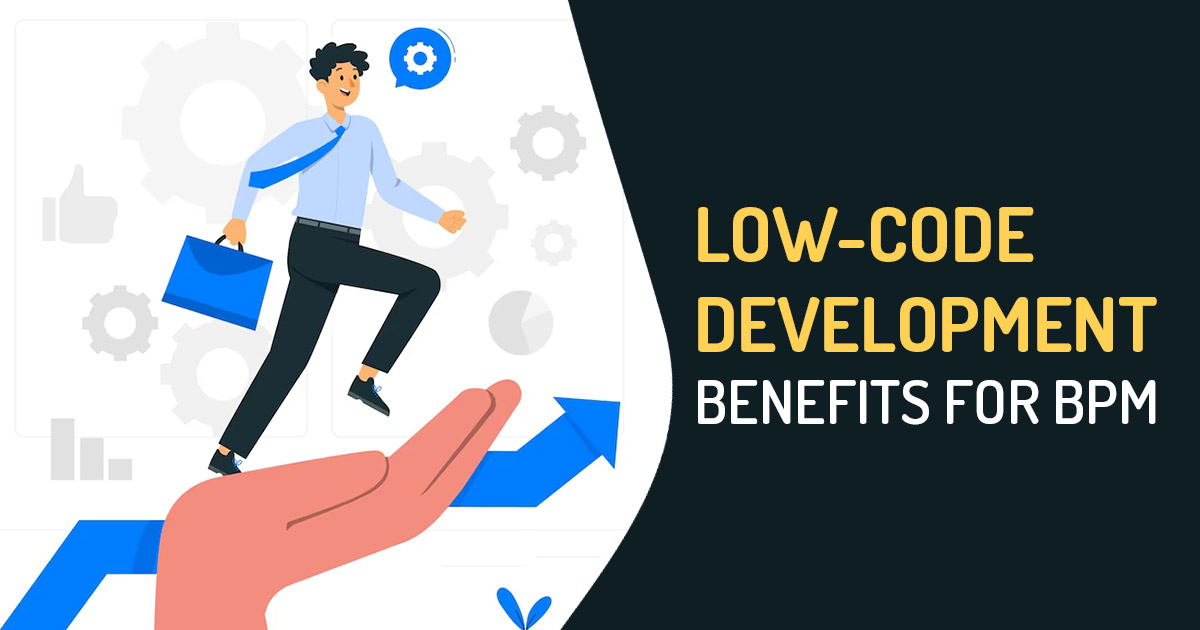
How low-code development platforms improve business process management and do away with the costs of bespoke coding.
Two of the distinguishing traits of every modern business are adaptability and ongoing development. More than ever, a company’s capacity to grow and modify its workflow potential in accordance with continuously shifting needs determines its level of success. The field of business process management, or BPM, has been successfully used to address these issues.
Task management, the division of labour, and production are examples of principles that precede BPM and have undergone technical advancement. Organizations have started adopting BPM during the past ten years to examine processes, gauge performance, and identify areas for development – all with the aim of increasing productivity.
The terms intelligent business process management, or iBPM, have become more popular as intelligence and automation have become fundamental components of BPM today. Automation and intelligence can take many different forms, such as intelligent process mining and the digitalization of business processes. Automating repetitive chores requires minimal to no human involvement.
The intelligent coordination and orchestration of people, linked devices, and applications in the service of business objectives constitute the core value proposition of iBPM. Businesses require the appropriate tools for gaining access to mission-critical information in the appropriate context, though, in order to make educated choices and provide superior customer service.
This data is dispersed among a variety of commercially available and custom-built apps at various businesses. It might be challenging or impossible to apply iBPM in such a fragmented setting. As a result, employees perform less effectively, and customers have a worse experience.
By bridging the gap between the high expenses of creating custom programmes from scratch and the inherent restrictions of off-the-shelf software, low-code development platforms (LCDPs) provide a superior option. A rapid supply of unique business applications is made possible by LCDPs, and individuals in charge of operations are given the ability to become citizen developers.
We shall examine how low code is a useful tool for BPM in this essay.
How BPMLCDP Uses Low-Code?
BPM is undoubtedly one of the most significant use cases for low code among many others. The creation of apps to automate processes is made simple for operations teams by handling tasks like workflow and process modelling in a visual environment. They build their apps using simple graphic notations seen in business process diagrams rather than code. Although there are alternative models, the Business Process Model and Notation (BPMN) created and maintained by the Object Management Group is the one that is considered to be the industry standard.
Users may apply business logic without having any programming experience by creating processes in a low-code environment. The beginning and finish of the process, the activities and choices involved, and the participants will all be specified in the diagram used to design the BPM app. An order request model, for instance, may begin when a client places an order and end when the order is processed. In this situation, the request might need to be approved by a human operator, thus, UI element is also required to support that interaction. Similar to visual website builders, LCDPs offer a drag-and-drop interface for constructing these user interfaces, also without the need for coding.
Operations teams may use an interactive analytics dashboard to track the success of their procedures once they have been launched. They will be made aware of any bottlenecks or other issues right away and be in a position to take appropriate action. By enabling users to add or change object classes to address more complicated problems or create totally new functions from scratch, an open-source LCDP goes even further.
Read Also: Essential Things Every Company to Know About LCNC Software
Rapidly Build & Supplies Business Applications
The advantage of little code software development that is most frequently mentioned is the capacity to quickly design and deploy business-critical applications. Low code can save the development time of new applications by 50 to 90% as compared to writing them from scratch. This is mostly because an LCDP is easier to use, which makes application development accessible to a larger audience. Any operations-side business user should be able to understand the workflow design and UI components in an LCDP, not the least because they are already familiar with the business logic the platform refers to.
Individuals and small teams may explore, prototype and release apps in days and weeks as opposed to months because of low code. Contrarily, traditional business software development typically gets started with someone on the leadership or operations side having a vision for what they want to accomplish, but not knowing how to make it happen. They then convey these concepts to a team of programmers, which frequently leads to misunderstandings and several revisions of the aforementioned software until a workable solution is found. But low code adheres to the maxim that you should perform a job yourself if you want it done well.
Collaboration and communication issues have frequently arisen between company decision-makers and their IT staff. Inevitably, this imbalance causes stifled productivity and protracted delays. For instance, even though the IT staff has excellent coding abilities, they might not be aware of the demands and goals of the company. Although operations teams may be aware of their company’s requirements, they are unlikely to have programming knowledge. Thanks to minimal code, even persons with a moderate level of technical knowledge may become citizen engineers. As a result, businesses can use data-driven insights to swiftly transform their ideas into workable prototypes and constantly improve their apps.
Data Arrangement for Business Process Management
The initial step in iBPM is just to automate regular tasks. In the digital era, change is the one thing that never changes, therefore, normal business procedures need to be able to do the same. For instance, in the case of the previously described buy request model, there can be a bottleneck during the authorization decision because of the significantly more purchase requests that are coming in. If so, the procedure may need to be changed such that only orders with a high value require manual authorization and all other purchase requests are automatically authorized. Additionally, specific adjustments might need to be made based on the circumstances, such as which department is submitting the purchase request or which goods or services are involved.
How can operations teams determine when the workflow, and therefore the software designed to automate and manage it, needs to be updated? Employees encounter delays while seeking the acquisition of items or services that are essential to their work because the person in charge of authorising requests may not indicate being overloaded until it is too late. Thankfully, low-code once more provides the solution in the shape of interactive analytics dashboards that will spot such bottlenecks as soon as they arise. Instead of waiting for complaints to come in, operations staff may then alter the workflow based on these data-driven insights.
Although business process mining and data aggregation are the low-code iBPM’s core components, they are also what propels your firm’s ongoing progress. Finding your organization’s most popular process pathways is just the beginning of automating additional time-consuming and repetitive business activities. However, you will be able to acquire operational data in a uniform and thorough manner by employing minimal code to combine your data sources and automate your procedures. This data records each workflow transaction and presents it in a user-friendly visual format to give actionable business analytics.
Easy Data Maintenance with LCDP
The first step in solving the problem is recognising what has to be changed. The next step is to implement such adjustments as soon as possible to get the most benefit possible from them. Applying upgrades in conventional software development is often a time-consuming, difficult procedure that is frequently dangerous. For instance, many new software releases encounter problems after being introduced to a real-world setting. This is in addition to the business software’s annual maintenance and support fees, which range from 20 to 25 per cent of the overall purchase price. In addition, these expenses can rise year over year, particularly in the case of older software.
Although BPM is founded on a set of tried-and-true principles that are mostly resistant to change, many business processes nevertheless require ongoing evaluation and improvement. This also holds true for the software used to automate these processes. Fortunately, an LCDP makes it simple to put changes into practice and keep up with rapidly changing corporate settings. If you want to add a new function, for instance, you generally drag and drop a new object class or UI element into the designer before recompiling the programme. This also implies that it is simple to onboard additional citizen developers for maintenance jobs; after all, making a modest change is considerably quicker and simpler than completely rewriting and redeploying the programme, even in a low-code environment.
Read Also: When Low-Code/No-Code Development Works & When It Doesn’t
While citizen developers may implement the bulk of updates by utilising established business logic and object classes, professional software developers can still apply updates by modelling logic and data to the LCDP, which they can also do internally in the case of open-source platforms. This results in less work for DevOps or cheaper expenses when software development is outsourced. In addition, unlike what many people think, this need not result in a surge in shadow IT. A lot of LCDPs enable administrators to define role-based permissions and thresholds for what may be modified and which quality control procedures such modifications must pass through before the app is released.
Develop & Optimize Business Through Low-code Platforms
Because each business has a distinct operational architecture, off-the-shelf solutions sometimes fall short of meeting demand. The development and delivery of software differ based on a wide range of factors, both from an internal and end-user viewpoint, which highlights the need for having full organisational control over your workflows, designs, and user interfaces. Without having to worry about the restrictions of proprietary systems or commercial software, businesses may develop and optimise their processes to suit their needs. An open-source LCDP takes things a step further by granting businesses total digital control over their data assets.
Nearly all businesses rely on a number of different third-party services and apps, sometimes even hundreds. These dissimilar technologies frequently lead to data silos and all the associated inefficiencies. Since it is simpler to integrate and manage outside apps from a single place when using Low-code platforms to improve BPM, you may regain control over your operational infrastructure. Even if the applications and services may be hosted elsewhere and offered by several suppliers, being able to control everything in one location offers you a 360-degree perspective of your business’s activities. By not being constrained by the capabilities of any one provider, you may apply BPM and automation to data that you trust.
It is also quite advantageous to own and have control over the user experience and design. For instance, these variables have a significant impact on how effective manual procedures are. The end-user experience may be improved with an LCDP based on input from your stakeholders. As a result, the restrictions imposed by commercial software are no longer necessary to limit their experience. In other words, rather than having to wait for a third-party provider to respond to an update request, any input can often be applied promptly.
Closure: With good cause, the low-code ecosystem is continuously changing. Operations teams now have the tools at their disposal to create their own applications for controlling and automating standard business processes, thanks to the significantly lower entry barriers. Low code enables the consolidation and automation of a wide range of corporate activities, from back-office solutions to sector-specific apps. Additionally, these procedures may be modified and improved over time by seeing repeating data trends and fresh prospects for development.








